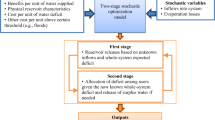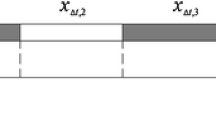Abstract
In oil reservoir management, one of the major challenges is the search for the best production plan under geological uncertainties. One way to conduct optimal management of reservoirs under uncertainty is through robust optimization, which uses a set of realizations to approximate some statistics of the reservoir properties. The statistics considered here are the mean and standard deviation of the net present value (NPV). In this work, two different formulations for the optimal robust management of oil reservoirs are considered using a unique objective function. One formulation is also presented in a multi-objective context. All of these are employed to solve two benchmark problems. As all the proposed formulations are very computationally intensive, surrogate models are used for the several function calls required in both optimization and uncertainty propagation. The results obtained by the proposed strategies proved to be efficient for both single and multi-objective problems. For the two studied problems, using 500 and 100 realizations, respectively, the obtained results, when compared with the ones obtained by reactive control strategy, show an increase of mean NPV more than 10% in average. The multi-objective optimization results for both investigated reservoirs show an optimal robust Pareto front that can be used to make a trade-off between the mean of NPV and the mean of water injection. This work shows that surrogate models, a special subset of the full set of reservoir realizations and parallel processing should be used for the application in robust managements of practical reservoir engineering problems.













Similar content being viewed by others
References
Naevdal G, Brouwer D, Jansen J (2006) Waterflooding using closed-loop control. Comput Geosci 10(1):37–60
Asadollahi M (2012) Waterflooding optimization for improved reservoir management. Ph.D. thesis, NTNU, Norway
Horowitz B, Afonso SM, Mendonça C (2013) Surrogate based optimal waterflooding management. J Petrol Sci Eng 112:206–219
Renard P, Alcolea A, Gingsbourger D (2013) Stochastic versus deterministic approaches. Environmental modelling: finding simplicity in complexity, 2nd edn. Wiley, Hoboken, pp 133–149
Motta RS, Afonso SM, Lyra PR (2012) A modified NBI and NC method for the solution of N-multiobjective optimization problems. Struct Multidiscip O 46(2):239–259
Yang C, Card C, Nghiem LX, Fedutenko E (2011) Robust optimization of SAGD operations under geological uncertainties. SPE reservoir simulation symposium
Van Essen GM, Zandvliet M, Van den Hof P, Bosgra O, Jansen J (2009) Robust waterflooding optimization of multiple geological scenarios. SPE 102913-PA. SPE J 14(1):202–210
Capolei A, Suwartadi E, Foss B, Jørgensen JB (2013) Waterflooding optimization in uncertain geological scenarios. Comput Geosci 17(6):991–1013
Krogstad JA (2015) Control-switching strategies for reservoir water-flooding management. Master project
Siraj MM, Van den Hof P, Jansen JD (2016) Robust optimization of water-flooding in oil reservoirs using risk management tools. IFAC PapersOnLine 49(7):133–138
Yasari E, Pishvaie MR, Khorasheh F, Salahshoor K, Kharrat R (2013) Application of multi-criterion robust optimization in water-flooding of oil reservoir. J Petrol Sci Eng 109:1–11
Wang H, Echeverría-Ciaurri D, Durlofsky L, Cominelli A (2012) Optimal well placement under uncertainty using a retrospective optimization framework. SPE J 17(1):112–121
Fei J, Yarus J, Chambers R (2016) Data mining methodologies to reduce the uncertainty of reservoir selection. AAPG annual convention and exhibition
Gutmann HM (2001) A radial basis function method for global optimization. J Glob Optim 19(3):201–227
Forrester A, Sobester A, Keane A (2008) Engineering design via surrogate modelling: a practical guide. Wiley, Hoboken
CMG (2014) User’s guide. Computer Modeling Group Ltd., Calgary
Alexandrov N, Dennis JJ, Lewisand R, Torczon V (1998) A trust region framework for managing the use of approximation models in optimization. Struct Optim 15(1):16–23
Brouwer D, Jansen J (2004) Dynamic optimization of waterflooding with smart wells using optimal control theory. SPE J 9(4):391–402
Li SH, Deutsch CV, Si JH (2012) Ranking geostatistical reservoir models with modified connected hydrocarbon volume. In: Ninth international geostatistics congress, pp 11–15
Deutsch C, Srinivasan S (1996) Improved reservoir management through ranking stochastic reservoir models. SPE/DOE improved oil recovery symposium
McLennan JA, Deutsch CV (2005) Local ranking of geostatisical realizations for flow simulation. Technical report 114, CCG annual report 7, University of Alberta, Edmonton
Ballin P, Journel A, Aziz K (1992) Prediction of uncertainty in reservoir performance forecasting. J Can Petrol Technol 31(04):52–62
Harkanth S, Phulpagar B (2013) A survey on clustering methods and algorithms. Int J Comput Sci Inf Technol 4(5):687–691
Arthur D, Vassilvitskii S (2007) K-means ++: the advantages of careful seeding. In: Proceedings of the eighteenth annual ACM-SIAM symposium on discrete algorithms. Society for Industrial and Applied Mathematics, pp 1027–1035
Jain AK (2010) Data clustering: 50 years beyond K-means. Pattern Recogn Lett 31(8):651–666
Shirangi MG, Durlofsky L (2016) A general method to select representative models for decision making and optimization under uncertainty. Comput Geosci UK 96:109–123
Igual L, Seguí S (2017) Introduction to data science: a python approach to concepts, techniques and applications. Springer, Berlin
Berchtold S, Böhm C, Keim DA, Kriegel HP (1997) A cost model for nearest neighbor search in high-dimensional data space. In: Proceedings of the sixteenth ACM SIGACT-SIGMOD-SIGART symposium on principles of database systems, pp 78–86
Parsons L, Haque E, Liu H (2004) Subspace clustering for high dimensional data: a review. ACM SIGKDD Explor Newsl 6(1):90–105
Giunta A, Eldred M (2000) Implementation of a trust region model management strategy in the DAKOTA optimization toolkit. 8th AIAA/USAF/NASA/ISSMO symposium on multidisciplinary analysis and optimization. AIAA-2000-4935, Long Beach, CA
Giunta A, Wojtkiewicz S, Eldred M (2003) Overview of modern design of experiments methods for computational simulations. In: Proceedings of the 41st AIAA aerospace sciences meeting and exhibit, Reno, NV, AIAA-2003-0649
Giunta A (2002) Use of data sampling, surrogate models, and numerical optimization in engineering design. Paper AIAA-2002-0538 in proceedings of the 40th AIAA aerospace sciences meeting and exhibit, Reno, NV
Wild SM, Regis RG, Shoemaker CA (2008) ORBIT: optimization by radial basis function interpolation in trust-regions. SIAM J Sci Comput 30(6):3197–3219
Elsayed K, Vucinic D, d’Ippolito R, Lacor C (2012) Comparison between RBF and Kriging surrogates in design optimization of high dimensional problems. In: Proceedings of 3rd international conference on engineering optimization, Rio de Janeiro, Brazil, pp 1–5
Hardy RL (1971) Multiquadric equations of topography and other irregular surfaces. J Geophys Res 76(8):1905–1915
Krishnamurthy T (2003) Response surface approximation with augmented and compactly supported radial basis functions. In: 44th AIAA/ASME/ASCE/AHS/ASC structures, structural dynamics, and materials conference
Wu Z (1995) Compactly supported positive definite radial functions. Adv Comput Math 4(1):283
Eldred MS, Giunta AA, Collis SS (2004) Second-order corrections for surrogate-based optimization with model hierarchies. Paper AIAA-2004-4457 in proceedings of the 10th AIAA/ISSMO multidisciplinary analysis and optimization conference, Albany, NY
Perez V, Apker T, Renaud J (2001) Parallel processing in sequential approximate optimization. In: 43rd AIAA/ASME/ASCE/AHS/ASC structures, structural dynamics, and materials conference, p 1589
Sharma G, Martin J (2009) MATLAB®: a language for parallel computing. Int J Parallel Prog 37(1):3–36
Eager DL, Zahorjan J, Lazowska ED (1989) Speedup versus efficiency in parallel systems. IEEE Trans Comput 38(3):408–423
Collette Y, Siarry P (2003) Multiobjective optimization—principles and case studies, 1st edn. Springer, Berlin
Gaspar AT, Santos A, Schiozer D (2013) Caso de Estudo para Seleção de Estratégia de Explotação de Reservatório Baseado no Campo UNISIM-I. Unicamp, Campinas
Pinto JW (2014) Use of sequential approximate optimization to single and multiobjective reservoir management problems. Master thesis, Civil Engineering Department, UFPE, Recife, Brazil (in Portuguese)
Acknowledgements
The authors acknowledge the financial support for this research given by Energi Simulation, Brazilian research council (CNPq), PETROBRAS, FACEPE and Federal University of Pernambuco (UFPE).
Author information
Authors and Affiliations
Corresponding author
Ethics declarations
Conflict of interest
The authors declare that the research was conducted in the absence of any commercial or financial relationships that could be construed as a potential conflict of interest.
Additional information
Technical Editor: Marcelo A. Trindade, Dr.
Publisher's Note
Springer Nature remains neutral with regard to jurisdictional claims in published maps and institutional affiliations.
Rights and permissions
About this article
Cite this article
Pinto, J.W.O., Afonso, S.M.B. & Willmersdorf, R.B. Robust optimization formulations for waterflooding management under geological uncertainties. J Braz. Soc. Mech. Sci. Eng. 41, 475 (2019). https://doi.org/10.1007/s40430-019-1970-x
Received:
Accepted:
Published:
DOI: https://doi.org/10.1007/s40430-019-1970-x




